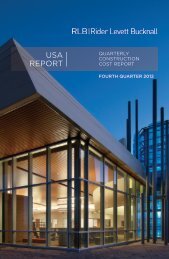International Construction Cost Commentary - Rider Levett Bucknall
International Construction Cost Commentary - Rider Levett Bucknall
International Construction Cost Commentary - Rider Levett Bucknall
Create successful ePaper yourself
Turn your PDF publications into a flip-book with our unique Google optimized e-Paper software.
St David’s II in Cardiff which will effectively<br />
remove demand for retail development for<br />
some time. A number of key mixed use<br />
developments in the South West region<br />
have also been cancelled or delayed while<br />
confidence remains low.<br />
The South West and Bristol Region is<br />
following the National Trend with the<br />
downturn leading to redundancies among<br />
contractors, construction consultants,<br />
property agents and developers.<br />
Public sector works carries on however,<br />
particularly in the Defence, Education<br />
and Health Sectors, with major projects<br />
development programmes planned over the<br />
next five years, for example the Defence<br />
Training Academy in Wales.<br />
We believe the next 12 months will be<br />
a difficult and challenging period for the<br />
construction market, however the low<br />
levels of activity within the commercial<br />
sector will to some extent be offset by<br />
continued public sector spending.<br />
Manchester<br />
As with other UK and Global markets<br />
the Manchester and North West<br />
market has seen a significant decline in<br />
construction activity in the last 6 months.<br />
As the economy continues to languish,<br />
construction activity is likely to deteriorate<br />
further through 2009.<br />
The residential sector has been hit<br />
particularly hard, with North West house<br />
values suffering more than the UK average<br />
and with a substantial stock of apartments<br />
within Manchester remaining unsold. Local<br />
Registered Social Landlords have revised<br />
their strategies away from constructing<br />
shared ownership homes toward a rental<br />
accommodation bias.<br />
The commercial office market is<br />
experiencing a slowdown, as a number of<br />
major office schemes completing in 2009<br />
and 2010 have yet to secure occupiers,<br />
providing a surplus of accommodation and<br />
deterring developers from progressing new<br />
projects. It is predicted that Manchester<br />
city centre office rents are likely to perform<br />
worse than in any other major centre<br />
outside London. Two major occupiers who<br />
were recently looking for nearly 200,000<br />
square feet of accommodation have put<br />
searches on hold.<br />
A number of key developments in the<br />
North West have been cancelled or<br />
delayed, including Liverpool Football<br />
Club’s new stadium (£350m) and Stockport<br />
town centre redevelopment (£500m).<br />
Other large commercial developments<br />
are rumoured to be in delay or are being<br />
scaled down.<br />
The downturn has now led to redundancies<br />
starting to escalate among contractors,<br />
construction consultants, property agents,<br />
developers and even legal firms, with<br />
insolvencies also starting to rise.<br />
However, quasi public sector schemes<br />
remain a strong contributor to the<br />
market. North West universities such as<br />
Manchester Metropolitan, Liverpool and<br />
University of Cumbria all have significant<br />
capital projects in the pipeline, and the<br />
Government’s Housing Market Renewal<br />
Programme has over £500m of funding<br />
allocated to five key North West regions.<br />
Although the contraction of the market<br />
has led to more competitive levels of<br />
tendering, care should be taken regarding<br />
advising that overall construction prices will<br />
fall significantly due to the continued high<br />
price of materials and the poor levels of<br />
exchange rates.<br />
In summary, whilst the outlook for the<br />
commercial sector is poor, public sector<br />
spending is compensating to some degree,<br />
so it is not all bad news. However, the next<br />
12 months will be a difficult and challenging<br />
period for the North West construction<br />
market.<br />
Sheffield<br />
<strong>Construction</strong> work has slowed down<br />
dramatically across the area. The<br />
Sevenstones retail development, which<br />
will provide 860,000 ft2 in the heart of the<br />
city centre has been delayed until at least<br />
4th Quarter 2009. This has had a knock<br />
on effect on ancilliary demolition projects,<br />
which have also been shelved. The Moor<br />
development, which is set to revive the<br />
main pedestrian shopping area in the city<br />
with its indoor market has also been put<br />
on hold.<br />
Residential, office and hotel developments,<br />
which commenced prior to the global crisis<br />
are continuing to be completed, however<br />
new schemes are slow to reach the market<br />
Birmingham<br />
The Birmingham market has been severely<br />
hit by the credit crunch. Major schemes<br />
have been put on hold due to a lack of<br />
availability of finance and recent cuts in<br />
interest rates have not yet filtered through<br />
to the market.<br />
We envisage a reduction in tender prices<br />
over the next 12 to 18 months driven<br />
by increased competition for a reduced<br />
workload and reducing material prices,<br />
driven down by a sharp reduction in<br />
worldwide demand. However, due to the<br />
decrease in the value of sterling comparable<br />
to currencies used in trading commodities<br />
and construction materials, the full effect of<br />
the reduction in material prices will not be<br />
realised in the UK.<br />
Contractors and subcontractors are<br />
reducing margins in order to secure<br />
workload.<br />
This cannot be sustainable in the long term,<br />
and we see this resulting in a reduction in<br />
the general contracting market if market<br />
conditions and workload do not improve in<br />
the near future.<br />
The upside of the reduction in tender<br />
prices will provide clients with funding<br />
with a window of opportunity to procure<br />
projects at lower cost than has been<br />
recently available.<br />
Dubai<br />
The rapid ascent of the Dubai construction<br />
market has been slowed somewhat by<br />
the fall-out from global economic woes.<br />
Recent announcements of several major<br />
high-profile projects such as the Trump<br />
<strong>International</strong> Hotel and Tower being<br />
deferred or postponed, have followed hard<br />
on news of sharp falls in property values<br />
and the retreat of overseas investors.<br />
These effects are of course demonstrative<br />
of the impact of extremely problematic<br />
global economic conditions, but they<br />
also demonstrate the enormous external<br />
investment in Dubai from around the globe.<br />
However, it has to be said that no-one<br />
could be better-placed to withstand the<br />
economic storm than the Emirates, given<br />
the huge value of natural resources and the<br />
fact that a recovering global economy will<br />
once again demand the key product, namely<br />
oil, reliance on which the UAE is seeking<br />
to diversify away from by building into the<br />
service, tourism and industrial markets.<br />
As the Dubai construction economy<br />
scales back to shelter from the storm,<br />
the outcome will be significant reductions<br />
in the annual levels of construction cost<br />
increase to which we have become<br />
accustomed. Depending on the severity of<br />
the ongoing economic difficulties and the<br />
point at which the bottom is reached, there<br />
is of course the potential for large-scale<br />
deferral of work, as is evidenced by the<br />
sheer volume of currently ongoing work.<br />
That can be very rapidly affected by funding<br />
and viability concerns, which would spill<br />
over into demand for labour and materials.<br />
15<br />
INTERNATIONAL CONSTRUCTION COST COMMENTARY: January 2009

















